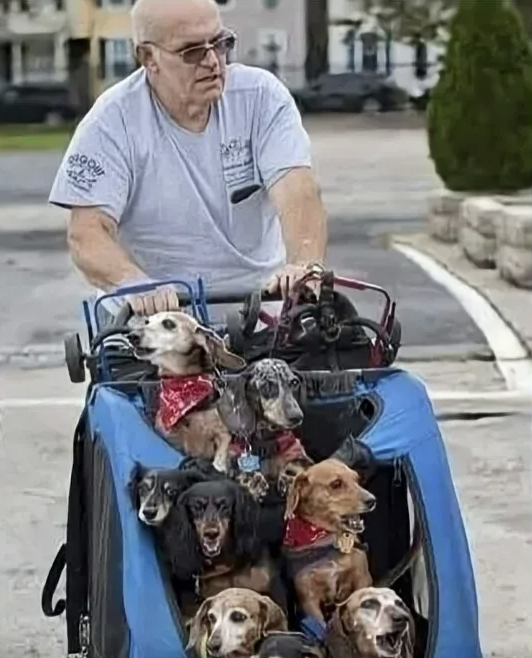
Every morning, Gregory pushes a stroller filled with dogs who can’t walk on their own. It’s an unusual sight—an older man in glasses, carefully navigating sidewalks with what looks like a mobile doggy daycare. But look closer and you’ll see these aren’t ordinary dogs. They’re paralyzed German Shepherds, Labradors, mixed breeds whose back legs don’t work, whose bodies have betrayed them but whose spirits remain intact.
It started with Max, Gregory’s own paralyzed German Shepherd. The vet’s recommendation was straightforward and devastating: put him down. Max couldn’t walk. His quality of life would be poor. It would be the kindest thing.
But Gregory looked at Max—at his bright eyes, his wagging tail, his obvious desire to still be part of the world—and couldn’t accept that verdict. Instead of ending Max’s life, he built him a wheelchair. Custom-designed, carefully fitted, giving Max’s front legs the support they needed while wheels replaced the back legs that no longer worked.
When Max rolled forward for the first time, tail wagging with pure joy, Gregory found his purpose.
Now he takes dozens of paralyzed dogs to the park daily. He attaches their custom wheelchairs, positions them carefully, and lets them run. Or at least their version of running—wheels spinning, tongues lolling, tails wagging as they race across grass they thought they’d never feel again.
“People think they’re broken,” Gregory says, “but they just need help remembering how to run.”
The photo captures him mid-stride, pushing his special stroller loaded with dogs of all sizes and colors. Some wear bandanas, some have graying muzzles, all have that alert, happy expression of dogs who know they’re going somewhere good. Their wheelchairs are visible in the stroller—metal frames and wheels waiting to give them mobility, independence, joy.
Gregory’s philosophy is beautifully simple: “I can’t fix the whole world, but I can fix theirs.”
He can’t cure paralysis. Can’t undo the accidents or illnesses or genetic conditions that took these dogs’ ability to walk. Can’t change the fact that many owners, faced with expensive treatments or difficult care, chose to surrender their dogs rather than adapt.
But he can build wheelchairs. Can create support systems. Can take these dogs to the park every single morning and let them experience something most people take for granted—the simple joy of moving freely through the world.
There’s something profound in watching a paralyzed dog run for the first time in a wheelchair. The initial confusion gives way to understanding, then to pure, unbridled happiness. They remember what it felt like to chase, to explore, to move without pain or limitation. The wheelchair doesn’t fix them—it frees them.
People often ask Gregory why he does it. Why he spends his mornings building custom wheelchairs, why he dedicates his days to dogs that others have given up on, why he invests so much time and money into animals that society often deems disposable.
His answer is always the same: Because they’re not broken. They’re just different. And different doesn’t mean less worthy of love, less deserving of joy, less entitled to a good life.
Every morning, Gregory helps paralyzed dogs remember how to run. He gives them wheels where legs failed, support where bodies faltered, hope where vets offered only euthanasia. He transforms dogs that others said should be put down into dogs that race across parks with tails wagging and tongues flying.
Max, the German Shepherd whose imminent death sentence became a wheelchair and a second chance, started it all. He showed Gregory that paralysis doesn’t mean the end—it just means adaptation. And now dozens of other dogs benefit from that lesson, living full, joyful lives in wheelchairs built by a man who refused to accept that “broken” was a permanent condition.
“I can’t fix the whole world,” Gregory says, “but I can fix theirs.”
And every morning, in a park filled with dogs running on wheels instead of legs, that’s exactly what he does.